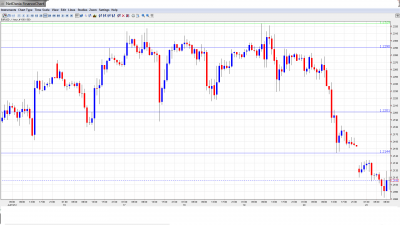EUR/USD hit a two-year low over fresh fears concerning Spain in Greece. In Spain, there are indications that the Spanish sovereign, and not just the banks will require a full bailout. As well, there are new concerns of a Greece exit from the euro, as the country may be unable to comply with its rescue package deadlines and could lose access to further bailout funds.
EUR/USD Technicals
- Asian session: Euro/dollar dropped below the 1.21 line, consolidating at 1.2088. The pair is unchanged in the European session.
- Current range: 1.20 to 1.2144.
Further levels in both directions:
- Below: 1.20, 1.1876 and 1.17.
- Above: 1.2144, 1.22, 1.2288, 1.2330, 1.2360, 1.24, 1.2440, 1.2520 and 1.2623.
- The pair has broken through the clear historic separator of 1.2150.
- 1.20 is the last line of support before the post crisis low of 1.1876.
Euro/Dollar down after fresh concerns over Greece, Spain – click on the graph to enlarge.
EUR/USD Fundamentals
-
14:00 Euro-zone Consumer Confidence. Exp. -20 points.
-
23:00 FOMC Member Sarah Bloom Raskin Speaks.
For more events and lines, see the Euro to dollar forecast
EUR/USD Sentiment
- Fresh worries over possible Grexit: Fears of a Greek exit from the Euro-zone are again surfacing. Greece is already running into difficulty meeting its bailout obligations, such as debt-to GDP targets, and this could jeopardize the bailout funds. Germany continues to take a tough line with Greece, as German Vice Chancellor Philipp Roesler warned that Greece must adhere to austerity measures in order to receive bailout funds.
- Sovereign Bailout for Spain?: Spain is due to receive some EUR 100 billion in rescue funds to bolster Spanish banks and some regional governments. However, the markets are now worried that the situations in Spain is so acute that a sovereign bailout (i.e. the country itself) will be needed instead. Underscoring the crisis, Spain’s Treasury Minister Cristobal Montoro announced that the recession would last into 2012, and GDP would fall 0.5% in 2013, reversing the original estimate of a 0.2% increase. Meanwhile, Spanish 10-year bonds were trading on Monday at a record 7.37%, well above the 7% threshold which is widely considered unsustainable.
- US weak releases continues: The US continued to produce weak data, as there was a host of poor data late last week. Unemployment claims jumped, Existing Home Sales hit a two-year low, and the Philly Fed Manufacturing Index fell below the market estimate. Clearly, the US road to recovery continues to be a slow and bumpy one. Weak US data could actually boost the dollar and hurt the euro, as investors may opt to stick to safe haven currencies such as the dollar.
- Is Germany catching the Euro-zone flu?: It’s no secret that Germany continues to be the workhorse of the Euro-zone economy, and in return, Berlin often calls the shots regarding financial matters, such as setting the bailout terms for the weaker members. However, there are increasing signs that the troubles plaguing the EZ are hurting the German economy. This includes a host of weak German economic data, diminishing confidence in the economy, and weak global growth. A Germany in decline could spell disaster for the struggling Euro-zone. Chancellor Angela Merkel’s remarks that she was uncertain if the Euro-zone would be successful were certainly not helpful, to say the least. Although she did say she was “optimistic”, her statements were enough to spook the already nervous markets.
- Italy’s struggles continues: The Euro-zone’s third largest economy is plagued by soaring borrowing costs, declining growth and the risk of contagion from Greece and Spain. Adding to the woes, the Moody’s credit agency lowered Italy’s credit rating last week. With this mountain of trouble, Italy may ask for a bailout sooner rather than later.

